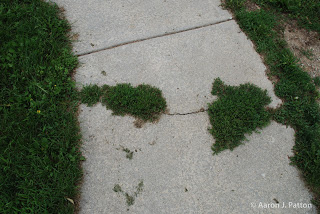This post kicks off a new series that we will be posting via turf tips called, “Weed of the Month”. In each post we’ll discuss a timely weed (one that you’re seeing at that particular time of year) and we will highlight its biology, identification, and control.
February’s weed of the month is Prostrate Knotweed
Biology: Prostrate knotweed (Polygonum aviculare) is an early germinating summer annual broadleaf that is often found in low-oxygen soils, including compacted areas next to sidewalks and previously flooded areas. Germination starts in late February and early March in many Midwest states.
Identification: Prostrate knot weed is the earlier summer annual weed to germinate in Indiana. Look for it first next to driveways and sidewalks. First germination has been in late-February or the first week of March the past three years in Indiana. Initial germinating weeds have a red hypocotyl.
The seed leaves (cotyledons) are very narrow and it almost appears to be a germinating grass upon first inspection.
As the plants mature they become tough, wiry, and prostrate in growth. This plant develops a thin taproot. It can be distinguished from prostrate spurge which exudes a milky white sap when it’s stem is broken.
Cultural control: Reduce soil compaction through aerification and improve drainage in areas prone to flooding.
Biological control: None known.
Chemical control: 2,4-D by itself will provide only fair control of prostrate knotweed, but when combined with triclopyr (Turflon Ester Ultra or Triclopyr 4) or dicamba (Banvel, Vanquish), it should provide excellent control in cool-season turf. There are many combination products that contain 2,4-D and dicamba, including Trimec 992 and SpeedZone. Combination products that contain 2,4-D and triclopyr include 4-Speed XT, Chaser, Chaser 2 Amine, Momentum FX2, Turflon II amine, and TZONE.
In warm-season turf, metsulfuron (Manor, Mansion, MSM) or the herbicides listed above will provide effective postemergence control of prostrate knotweed.
Preemergence control of prostrate knotweed can be achieved with late fall (November or December) applications of isoxaben (Gallery, Isoxaben 75WG). Other preemergence herbicides will also work, but are less effective than isoxaben. You can apply isoxaben in late winter, but spraying conditions are not typically favorable at that time of year and it is difficult to predict exactly when prostrate knotweed might germinate although it is usually in early March.
Aaron Patton, Turfgrass Extension Specialist

